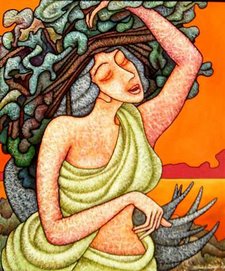 Alfama is Lisbon's most emblematic and one of the most interesting quarters. The most intersting way to get to know it is to walk around and get lost in the medivial alleys - it is impossible not to get lost in that labyrinth!
Alfama is Lisbon's most emblematic and one of the most interesting quarters. The most intersting way to get to know it is to walk around and get lost in the medivial alleys - it is impossible not to get lost in that labyrinth!Portugal suffered a massive earthquake in 1755 which destroyed almost the whole city, as a result of which none of the older monuments remain. However, since Alfama's fiundation was dense bedrock, it survived the 1755 earthquake. No wonder, a walk through Alfama, is like a walk through history....
Alfama is like a village within a city and is made up of narrow streets, squares, churches, and white & pink houses with wrought-iron balconies with pots of colourful flowers...while you drive through the streets, you will suddenly come upon a square with a small bistro where locals and tourists alike are sitting and sipping coffee enjoying the summer sun... thats when you hop offthe car, get down, and join them for a lazy afternoon cuppa in the lovely summer sun!
I understand that Alfama was settled by the Romans and Visigoths but it was the Moors who gave the district its atmosphere and name (alfama means springs or bath, a reference to the hot springs found in the area). They were also responsible for the labyrinth of streets, which I believe were created as a defense system, and, at the same time served the dual purpose of keeping their homes to remain cool in the summer.
According to our car driver, most of the older residents in Alfama are people who have lived here all their lives. Unfortunately because the places are all rent controlled, many of them have become dilapidated.
Alfama is also home to St George's castle who is the patron saint of Lisbon. Other renovated buildings directly below the castle have been converted into some quaint and unique hotels. Alfama has influenced poets and novelists, and although Bairro Alto is the city's traditional Fado (typical Portugese melancholy music) quarter, it is Alfama that has always been the inspiration for Fado songs, and is becoming just as popular with Fado Houses.

Nothing in my writings nor in the photographs can capture the experience that is Alfama.... You need to spend time wandering in its higgedly piggedly streets, climb up and down undulating quarters, admire quaint little houses with people lounging in their wrought iron balconies, quiant houses that looked like they just walked out of my son's story book, narrow lanes where you squeeze against the walls to let the cars pass, tracks where brightly coloured trams chug along with people handing out from all sides, locals smiling and yelling out a friendly "ola" as you walk by, and, a sense of a tryst with history as you take in your surroundings...
...and while you romanticise about the place, you also realise that it is the poorer quarter of town...Alfama became inhabited by the fishermen and the poor, and its condition as the neighbourhood of the poor continues to this day....
I cant remember where I found this, but enclosed is a poem written about Alfama which captures the ethos of the place....




No comments:
Post a Comment